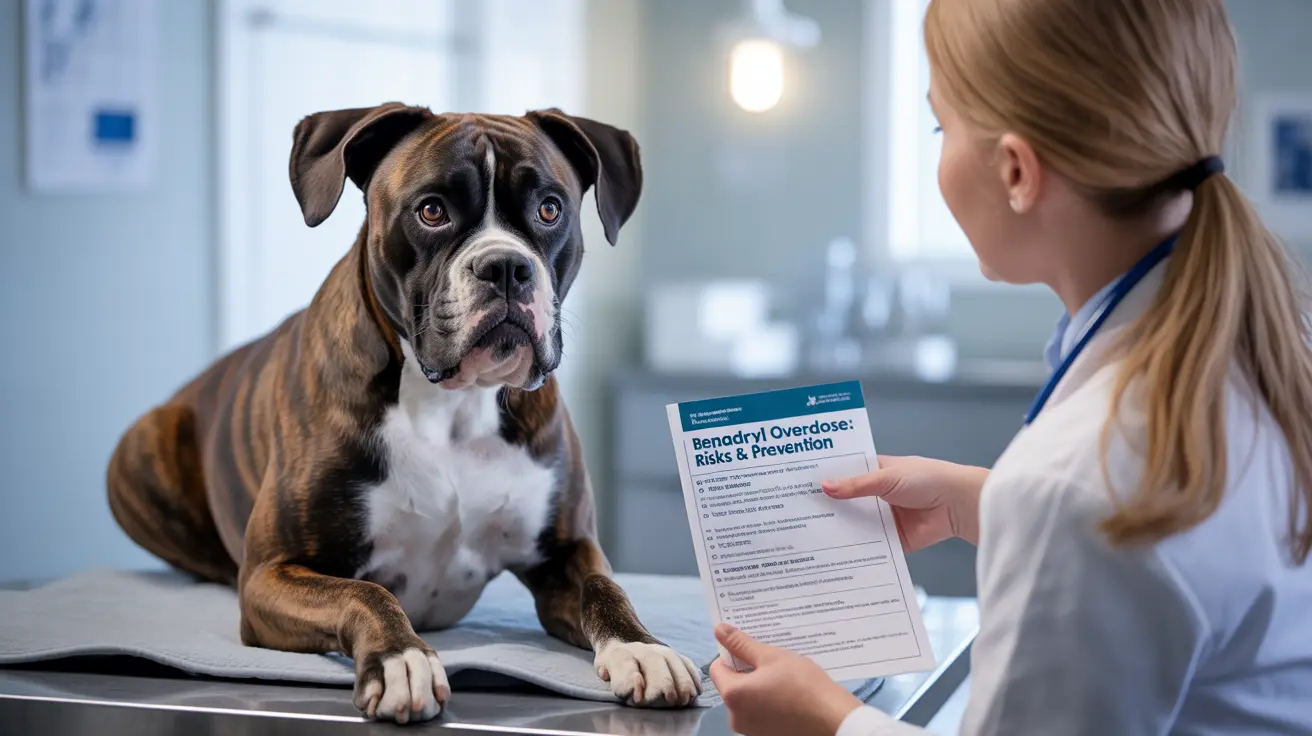Understanding Benadryl Toxicity in Dogs
Benadryl overdose can occur through accidental ingestion or improper dosing. While the medication is generally safe when used as directed by a veterinarian, the margin between a therapeutic dose and a toxic dose can be surprisingly narrow.
The recommended dosage for dogs is typically 2-4 mg per kilogram of body weight, given 2-3 times daily. However, factors such as your dog's age, health status, and other medications can affect how they process the drug.
Warning Signs of Benadryl Overdose
Immediate Symptoms
Early signs of Benadryl overdose often include:
- Extreme lethargy or paradoxical agitation
- Dry mouth and dilated pupils
- Rapid heartbeat
- Difficulty urinating
- Disorientation
Severe Symptoms
As toxicity progresses, more serious symptoms may develop:
- Seizures
- Respiratory distress
- Abnormal heart rhythms
- High blood pressure
- Coma
Emergency Response and Treatment
If you suspect your dog has overdosed on Benadryl, immediate veterinary care is crucial. Do not attempt to treat the overdose at home, as this could worsen the situation or delay vital professional care.
Treatment typically involves:
- Decontamination procedures
- IV fluid therapy
- Cardiac monitoring
- Seizure control if necessary
- Supportive care
Prevention and Safe Usage Guidelines
To prevent Benadryl overdose:
- Always consult your veterinarian before giving any medication
- Keep all medications securely stored
- Use only plain diphenhydramine formulations
- Never give time-release capsules
- Double-check dosage calculations
- Monitor your dog after administration
Alternatives to Benadryl
Several safer alternatives exist for treating allergies in dogs, including:
- Veterinary-prescribed antihistamines
- Natural remedies approved by your vet
- Environmental modifications
- Specialized diets
- Immunotherapy options
Frequently Asked Questions
What are the signs that my dog has overdosed on Benadryl?
Signs of Benadryl overdose include extreme lethargy or agitation, dry mouth, dilated pupils, rapid heartbeat, difficulty urinating, seizures, and respiratory distress. Any unusual behavior following Benadryl administration should be taken seriously.
How much Benadryl is safe to give my dog and when can it become lethal?
The safe dosage is 2-4 mg per kilogram of body weight, 2-3 times daily. Lethal doses can occur at approximately 24-30 mg/kg body weight, though lower doses can be fatal in dogs with health conditions or when combined with other medications.
What should I do if I think my dog has taken too much Benadryl?
Immediately contact your veterinarian or emergency animal hospital. Do not wait for symptoms to develop or attempt home treatment. Quick professional intervention is crucial for survival.
Can Benadryl cause death in dogs and what factors increase this risk?
Yes, Benadryl can be fatal to dogs when overdosed. Risk factors include underlying health conditions, age, concurrent medications, and use of inappropriate formulations (such as time-release capsules or combination products).
Are there safer alternatives to Benadryl for treating my dog's allergies?
Yes, several safer alternatives exist, including veterinary-prescribed antihistamines, specialized allergy medications, and natural remedies. Always consult your veterinarian to determine the best option for your dog's specific situation.
Conclusion
While Benadryl can be a useful medication when properly administered, its potential dangers cannot be overlooked. Understanding proper dosing, recognizing overdose symptoms, and knowing when to seek emergency care are essential for every dog owner. When in doubt, always consult your veterinarian before administering any medication to your pet.






